Related Research Articles
Crochet is a process of creating textiles by using a crochet hook to interlock loops of yarn, thread, or strands of other materials. The name is derived from the French term croc, which means 'hook'. Hooks can be made from a variety of materials, such as metal, wood, bamboo, bone or plastic. The key difference between crochet and knitting, beyond the implements used for their production, is that each stitch in crochet is completed before the next one is begun, while knitting keeps many stitches open at a time. Some variant forms of crochet, such as Tunisian crochet and broomstick lace, do keep multiple crochet stitches open at a time.

Yarn is a long continuous length of interlocked fibres, used in sewing, crocheting, knitting, weaving, embroidery, ropemaking, and the production of textiles. Thread is a type of yarn intended for sewing by hand or machine. Modern manufactured sewing threads may be finished with wax or other lubricants to withstand the stresses involved in sewing. Embroidery threads are yarns specifically designed for needlework. Yarn can be made of a number of natural or synthetic materials, and comes in a variety of colors and thicknesses. Although yarn may be dyed different colours, most yarns are solid coloured with a uniform hue.

Wearable art, also known as Artwear or "art to wear", refers to art pieces in the shape of clothing or jewellery pieces. These pieces are usually handmade, and are produced only once or as a very limited series. Pieces of clothing are often made with fibrous materials and traditional techniques such as crochet, knitting, quilting, but may also include plastic sheeting, metals, paper, and more. While the making of any article of clothing or other wearable object typically involves aesthetic considerations, the term wearable art implies that the work is intended to be accepted as an artistic creation or statement. Wearable art is meant to draw attention while it is being displayed, modeled or used in performances. Pieces may be sold and exhibited.
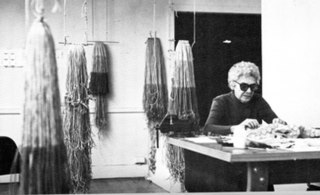
Claire Zeisler was an American fiber artist who expanded the expressive qualities of knotted and braided threads, pioneering large-scale freestanding sculptures in this medium. Throughout her career Zeisler sought to create "large, strong, single images" with fiber.
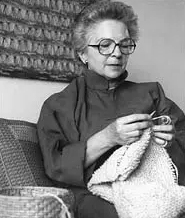
Mary Walker Phillips, was an American textile artist, author and educator. She revolutionized the craft of hand knitting by exploring knitting as an independent art form. Her hand-knit tapestries and other creative pieces are exhibited in museums in the U.S. and Europe. She was honored as a fellow by the American Craft Council (ACC) in 1978.

Stephanie Syjuco, is a Filipino-American conceptual artist and educator. Born in the Philippines, she moved to the San Francisco Bay Area in 1977. Syjuco received her MFA from Stanford University in 2005, and BFA in Sculpture from the San Francisco Art Institute in 1995. She currently lives and works in Oakland, California.

Feliciano Centurión was a Paraguayan visual artist who lived most of his life in Argentina. He was known for his work in textiles that included embroidery, crochet, knitting and blanket-making.
Arline Fisch is an American artist and educator. She is known for her work as a metalsmith and jeweler, pioneering the use of textile processes from crochet, knitting, plaiting, and weaving in her work in metal. She developed groundbreaking techniques for incorporating metal wire and other materials into her jewelry.
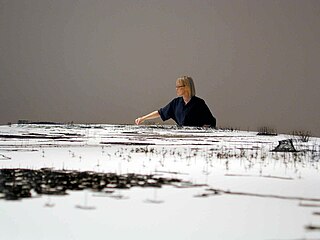
Anne Wilson is a Chicago-based visual artist. Wilson creates sculpture, drawings, Internet projects, photography, performance, and DVD stop motion animations employing table linens, bed sheets, human hair, lace, thread and wire. Her work extends the traditional processes of fiber art to other media. Wilson is a professor in the Department of Fiber and Material Studies at The School of the Art Institute of Chicago.
L.J. Roberts is an American textile artist. Roberts, who is genderqueer and uses singular they pronouns, explores queer and feminist politics in their work.
Wall Hangings was an exhibition of textile fiber art at Museum of Modern Art from 25 February to 4 May 1969. It was planned in 1966 and toured 11 cities in 1968–1969.
Glenn Adamson is an American curator, author, and historian whose research and work focuses on the intersections of design, craft, and contemporary art. Adamson is currently editor-at-large of The Magazine Antiques, editor of Journal of Modern Craft, a freelance writer and a curator. Adamson has held previous notable appointments as the Director of the Museum of Arts and Design, Head of Research at the Victoria and Albert Museum, and as Curator at the Chipstone Foundation.
Elisa Auther is the Mildred Lasdon Chief Curator at the Museum of Arts and Design in New York City.
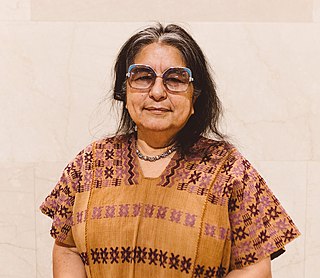
Consuelo Jiménez Underwood is an American fiber artist, known for her pieces that focus on immigration issues. She is an indigenous Chicana currently based in Cupertino, California. As an artist she works with textiles in attempt to unify her American roots with her Mexican Indigenous ones, along with trying to convey the same for other multicultural people.
Raul de Nieves is a multimedia artist, performer, and musician. He lives and works in Brooklyn, New York.
Tracy Krumm is an American textile artist, craft educator, and curator based in St. Paul, Minnesota. Krumm's work combines metalworking and crochet; crafting items such as curtains and clothing out of metals and wire.
Susan Goldstine is an American mathematician active in mathematics and fiber arts. She is a professor of mathematics at St. Mary's College of Maryland, and the Steven Muller Distinguished Professor in the Sciences at St. Mary's College.
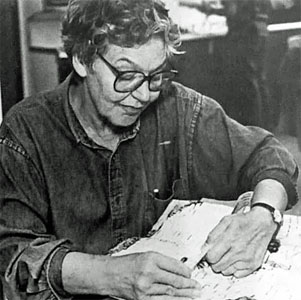
Lillian Elliott was an American fiber artist, and textile designer. She is known for her innovative basket craft.
Diedrick Brackens is an American artist and weaver. Brackens is well known for his woven tapestries that explore African American and queer identity.
References
- ↑ "Josh Faught | California College of the Arts". www.cca.edu. Retrieved 2018-02-14.
- ↑ Sarah Parrish, "Josh Faught" in Fiber: Sculpture 1960-Present. Institute of Contemporary Art/Boston: China 2014. Print.
- ↑ Auther, Elissa (February 26, 2015). "He is survived by his longtime companion: Feeling in the Work of Josh Faught". Art Practical. Retrieved July 1, 2016.
- ↑ SFMOMA bio
- ↑ Elissa Auther, "He Is Survived by His Longtime Companion: Feeling in the Work of Josh Faught" in Nation Building: Craft and Contemporary American Culture. Bloomsbury Academic: New York 2016. Print.
- ↑ "Fake snacks and jack-o'-lanterns: Josh Faught takes us to the Neptune Society Columbarium". YouTube. San Francisco Museum of Modern Art. September 10, 2013. Retrieved June 29, 2016.
- ↑ "Fiber Art: The Queer Kid on the Bus | Art21 Magazine". Art21 Magazine. Retrieved 2018-02-07.
- ↑ "People Finder - California College of the Arts - Portal". portal.cca.edu. Retrieved 2020-07-24.
- ↑ "Graduate Lecture Series: Josh Faught". Pacific Northwest College of Art. November 11, 2019. Retrieved 2024-03-26.
- ↑ Magazine, Wallpaper* (2019-10-07). "Fashion's finest moments at Frieze Week 2019". Wallpaper*. Retrieved 2020-07-24.
- ↑ "Frieze London 2018 review: bleak humour, female pioneers and more diversity - a-n The Artists Information Company" . Retrieved 2020-07-24.
- ↑ "Josh Faught: Sanctuary". www.e-flux.com. Retrieved 2020-07-24.
- ↑ "12 Years in, NADA Miami Beach Still Feels the Same: Different". Hyperallergic. 2015-12-05. Retrieved 2020-07-24.
- ↑ Patel, Alpesh Kantilal. "Artforum Picks". Artforum. Retrieved July 1, 2016.
- ↑ Thompson, Susannah (December 2014). "Josh Faught: I know I Came into this Room for a Reason". Art Review. Retrieved July 1, 2016.
- ↑ "Collecting as Collaboration: Launch Pad Brings Artists Directly into Collector Sarah Elson's Home". ArtSlant. Retrieved 2020-07-24.
- ↑ "Josh Faught at The Neptune Society Columbarium, San Francisco". Droste Effect Mag. 2013-10-21. Retrieved 2020-07-24.
- ↑ Fowler, Nancy. "Take Five: STL-born artist Josh Faught on 'Snacks' and sexual orientation". news.stlpublicradio.org. Retrieved 2020-07-24.
- ↑ "Artissima 2013". www.domusweb.it. Retrieved 2020-07-24.